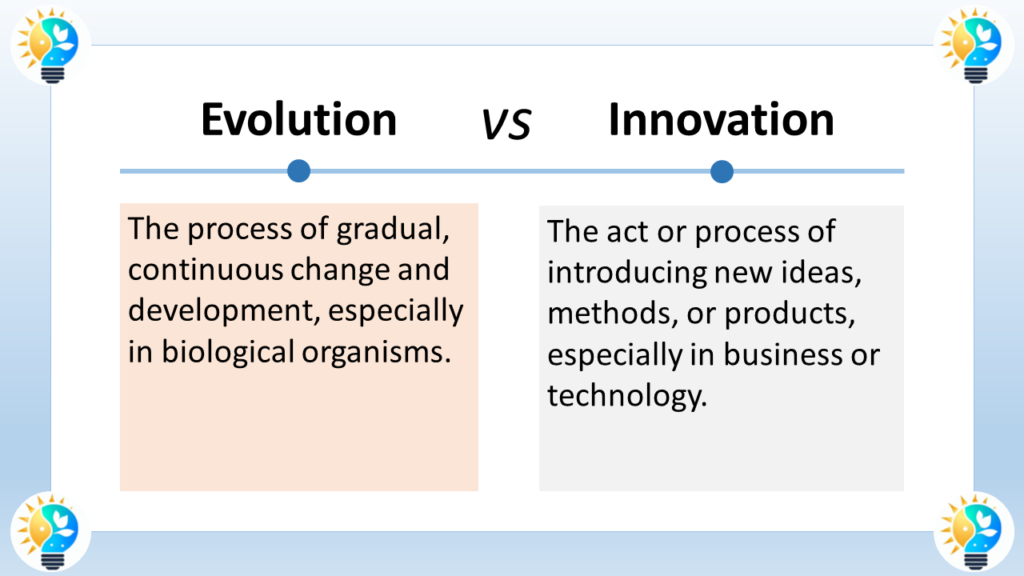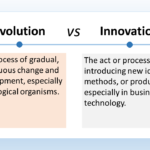The difference between evolution and innovation revolves around the nature of change and development in various contexts, such as biological processes, technological advancements, and organizational strategies.

Definition
Evolution
Evolution is the gradual process of change and development, often referring to the natural adaptation of organisms to their environment over many generations.
- Characteristics of Evolution:
- Gradualism: Changes occur incrementally over a long period.
- Natural Selection: Traits that enhance survival and reproduction tend to persist.
- Cumulative: Each small modification builds upon the previous ones.
Innovation
Innovation is the act of introducing something new, such as a concept, method, or device, which significantly changes existing practices or creates new markets.
- Characteristics of Innovation:
- Novelty: Involves the creation of something entirely unprecedented.
- Implementation: Requires the practical application of ideas to be considered truly innovative.
- Paradigm Shift: Can lead to fundamental changes, often quickly, in industry, society, or behavior.
More Synonyms on innovation, innovate and innovative
Innovation Terms

Innovation is considered as a driving force in progress.
It includes the introduction of novel ideas, methods, or products that bring positive change and advancement.
For more information about innovations, check our glossary
Relationship and Relevance
While evolution is a natural or iterative process of adaptation and change, innovation is often a deliberate, human-driven effort to create change. In business and technology, evolution might refer to the steady improvement of products or systems, whereas innovation represents significant leaps forward.
The key differences between evolution and innovation are:
Evolution
- Refers to making incremental, gradual changes and improvements to existing products, processes or systems.
- Focuses on optimizing and refining what already exists, building on current knowledge and resources.
- Aims to achieve better results through small, iterative changes based on customer insights and feedback.
- Has a lower failure rate as it builds on existing foundations.
Innovation
- Refers to creating something entirely new - a novel product, service, process or business model that did not exist before.
- Involves a more radical, disruptive approach that challenges the status quo and explores uncharted territories.
- Driven by a desire to do things differently rather than just better, often based on visionary foresight.
- Has a higher failure rate as it involves greater uncertainty and risk-taking, but can also have greater potential impact.
In summary, evolution is about making incremental enhancements to existing solutions, while innovation is about creating fundamentally new solutions. Both evolutionary and revolutionary (innovative) approaches are important and complementary for organizations to thrive. The most effective leaders are able to balance and leverage both as needed.
Context for Using Each Term
- Evolution is used when discussing natural biological processes or the slow and steady development of technologies or organizational practices.
- Innovation is used when there is a breakthrough or a significant leap in thinking, technology, or methodology.
Example of Utilization
The transition from feature phones to smartphones reflects evolution in mobile technology, as it represents a series of incremental improvements over time. The invention of the smartphone itself, however, was an innovation as it introduced a new category of devices with capabilities far beyond making calls and sending texts.
In conclusion, evolution and innovation both involve change, but they do so in different ways. Evolution describes a more gradual process of change, often seen in nature or in the slow progression of technologies. In contrast, innovation implies a more abrupt or radical development, typically driven by intentional human design and creativity.
FAQ
Q: Can evolution occur without innovation?
A: While evolution often incorporates innovations, it can occur through small, incremental changes without major breakthroughs.
Q: Is innovation always beneficial?
A: Not necessarily. Some innovations may have unintended negative consequences or may not be widely adopted.
Q: How do evolution and innovation contribute to progress?
A: Evolution ensures long-term adaptation and improvement, while innovation provides rapid solutions and advancements to address specific challenges.
Q: Can innovation lead to evolution?
A: Yes, significant innovations can accelerate the evolutionary process in various fields, especially in technology and society.

